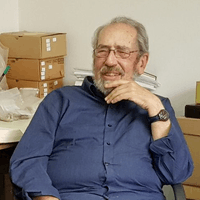Gabriel Barkay
| Gabriel Barkay | |
|---|---|
 Gabriel Barkay, June 2017 | |
| Born |
1944 (age 73–74) Hungary |
| Residence |
|
| Nationality | Israeli |
| Citizenship | Israel |
| Alma mater | Tel Aviv University |
| Occupation | Archaeologist |
| Employer | Bar-Ilan University, Hebrew University,[1] American Institute of Holy Land Studies and University of the Holy Land[2] |
| Title | Professor |
| Awards | Jerusalem Prize for Archaeological Research (1996)[2] |
| Website | http://www.gabrielbarkay.com/ |
Gabriel Barkay (sometimes misspelled Barkai) is an Israeli archaeologist.
Early life and studies
Born in 1944 in Hungary, he immigrated to Israel in 1950.[2]
Barkay studied archaeology, comparative religion and geography at Tel Aviv University, graduated summa cum laude, and received his PhD in Archaeology from the same university in 1985.[2] His dissertation was about LMLK seal impressions on jar handles. He participated in the Lachish excavations with David Ussishkin. His academic areas of interest include the archaeology of Jerusalem, biblical archaeology, burials and burial customs, art, epigraphy, and glyptics in the Iron Age.
Archaeological field work
First Temple Period tombs
In 1968-71, Barkay and David Ussishkin surveyed the Silwan necropolis from the time of the Judean Monarchy during the Iron Age, containing 50 rock-cut tombs of Judahite high government officials.[3] Barkay also excavated the Iron Age tombs on the grounds of the École Biblique in the early 1970s.
Priestly Blessing scrolls
Dr. Barkay's most famous discoveries are two small silver scroll amulets containing the priestly benediction from the Book of Numbers (Numbers 6:24-26), which he discovered in 1979 in a First Temple Period tomb at Ketef Hinnom. These amulets contain the oldest surviving biblically-related inscription discovered to date, dating back to the seventh century BCE and are to-date the only archaeological proof that passages from the Hebrew Bible as we know them were in circulation in the First Temple Period.
Temple Mount Sifting Project
In 2005, together with archaeologist Zachi Zweig, Barkay established the Temple Mount Sifting Project, a project funded by the Ir David Foundation and dedicated to recovering archaeological artifacts from 400 truckloads of earth removed from the Temple Mount by the Waqf and Israeli Islamic movement during 1996–2001. The construction included the establishment of the underground so-called El-Marwani Mosque at an ancient structure known since medieval times as Solomon's Stables, excavating a huge pit as an entrance to the structure, and reducing the platform level at the area north to the entrance.[4]
One of the findings of this project is a 7th-century BCE bulla (round clay seal affixed to documents), which became known as the "Bethlehem Seal". Dr. Barkay offered the first translation of the Hebrew three-line inscription: "In the 7th year, Bethlehem, for the king".[2]
Barkay points out to the findings from the Byzantine period - mainly ceramics and coins, including rare coins, but also architectural elements, some from churches. Some scholars claim that the Temple Mount was left bare by the Christian rulers, to conform with Jesus' prophecy that not a stone of the Temple complex will be left standing (Mark 13:2, Luke 21:6, Matthew 24:2) and in order to emphasise the Church of the Resurrection, but in Barkay's assessment, the findings prove that "in the Byzantine era the Temple Mount was a center of activity", as the place may have held churches and a marketplace.[5][6]
Teaching career
Barkay is currently an external lecturer at Bar Ilan University.
Media presence
Barkay frequently appears on the History Channel show The Naked Archaeologist, which is hosted by Simcha Jacobovici.
Awards
In 1996, Barkay received the Jerusalem Prize for his life's work as an archaeologist of Jerusalem.[1]
In 2014 he received the Moskowitz Prize for Zionism.[7]
References
- 1 2 "Gabriel Barkay". Biblical Archaeology Society. Archived from the original on 27 March 2012. Retrieved 29 October 2012.
- 1 2 3 4 5 The University of the Holy Land, Faculty & Staff: Dr. Gabriel Barkay, CV. Accessed 27 July 2018
- ↑ Hershel Shanks, The Tombs of Silwan, Biblical Archaeology Review (BAR) 20:03, May/June, 1994, via the Center for Online Judaic Studies (COJS) website
- ↑ Etgar Lefkovits (April 14, 2005). "Temple Mount relics saved from garbage". The Jerusalem Post. Archived from the original on March 2005. Retrieved August 10, 2014.
- ↑ Shahar Ilan (October 12, 2005). "Gems in the dirt". Haaretz. Retrieved 27 July 2018.
- ↑ Nadav Shragai (October 19, 2006). "First Temple artifacts found in dirt removed from Temple Mount". Retrieved August 10, 2014.
- ↑ "Lion of Zion Winners 2014". Retrieved 24 May 2015.
External links
- The Temple Mount Sifting Project
- "A Contentious Battle for the Temple Mount's Survival". Christian Broadcasting Network. Archived from the original on September 28, 2008.
- "Yahweh-600BC". Yahweh News Kingdom. Archived from the original on March 28, 2007.
- "Byzantine St. Stephen's Project Faculty & Staff". University of Notre Dame.
- Gabriel Barkay interview about the Silvan necropolis work after 1967. Tower of David Museum of the History of Jerusalem, "50 Years, 50 Faces" documentary project.